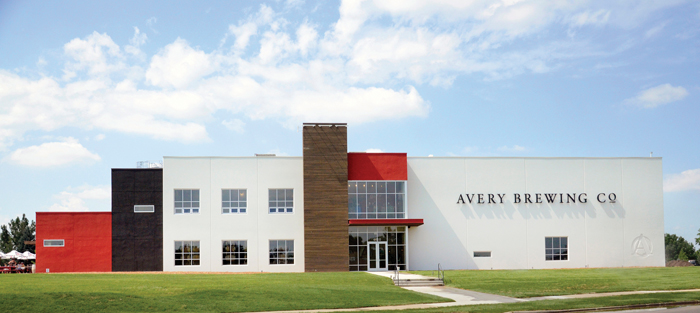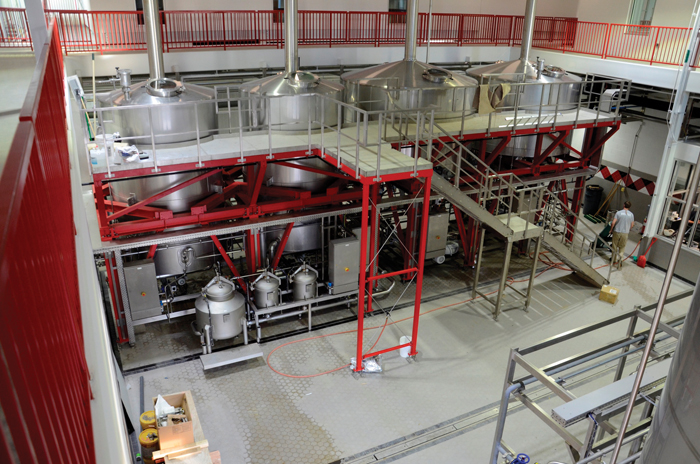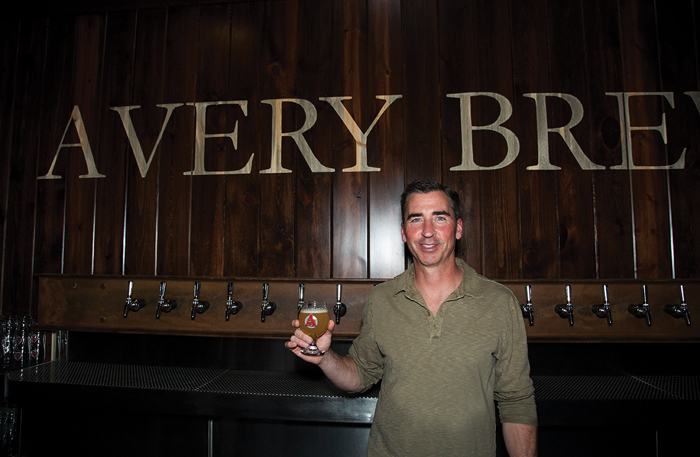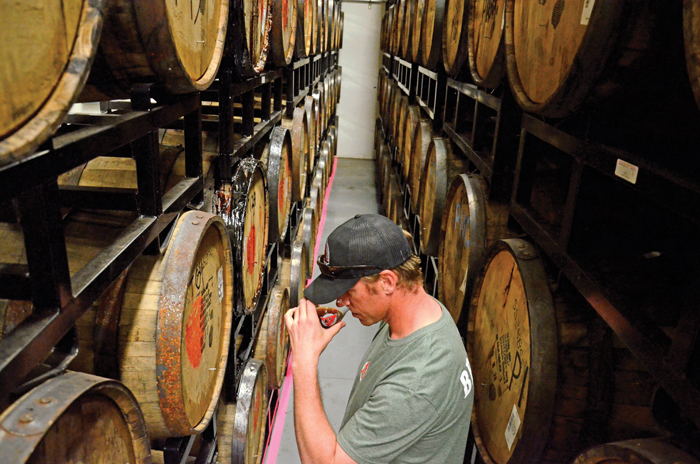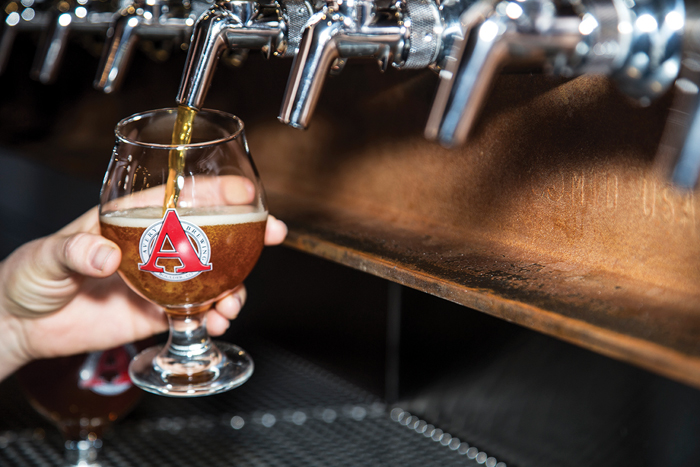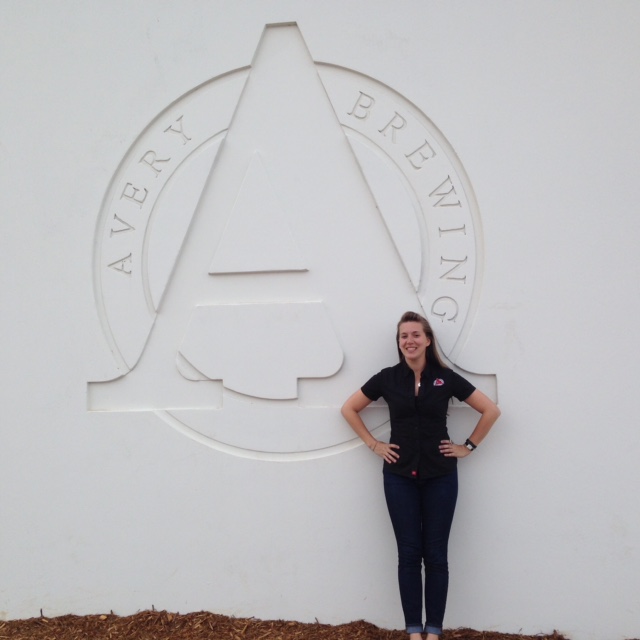“It’s all about producing beer that we are proud of and want to drink every single day.” This deceptively simple mantra is evident in the way that Avery Brewing Company approaches the art of beer-making. The motto may be simple, but the beer is anything but. Avery’s lineup of beers is about as diverse as you can imagine. Founder Adam Avery explains, “With my homebrewing, I was constantly pushing the envelope, creating new flavors and having a good time with it. We’ve just continued that train of thought with the brewery for the last 22 years.” The complexity of Avery’s beer extends beyond each recipe and flavor profile. It also comes from the creative solutions to capacity constraints and facility issues, and their unyielding commitment to quality control.
When I visited the Avery taproom, I had the pleasure of speaking with a few key members of the 168-person team. The personality of the staff shines through in the finished product. Avery remarks, “It’s fun–it’s a creative group that we’ve got here, and we welcome new ideas about beer.” As a brewery they’re more than willing to take a wild idea and run with it. For example, one of their most recent experiments is Rocky Mountain Olson’s, an oatmeal porter with malted milk balls. Inspiration for the beer came from the snack provided by Briess malting company. The staff regularly munches on them while brewing and somebody decided to create a beer recipe to go with it. Definitely a crazy concept, but I was a fan as soon as I had a sip–smooth, sweet and velvety on the palate. I appreciated it even more after I learned the recipe required hand-chopping malted milk balls for four hours (with dull knives, allegedly).
This is just one example of the fun experiments flowing out of the Avery taproom. I tasted a few as I met with Jess Steinitz (blessed with the official title of Beer Badassador) and Andy Parker, Chief Barrel Herder. As we discussed Avery’s challenges and successes, I was impressed with the camaraderie of the Avery team. I laughed a lot as I listened to jokes flying back and forth. The relaxed atmosphere went hand-in-hand with every beer I tasted. Avery’s fun-loving team is excited about new ideas and ingredients, from malted milk balls to passion fruit and Madeira wine barrels. But in the end they’re not playing around; every beer is executed to perfection. I returned to the taproom later that week, and each beer in my flight was complex, well-balanced, and well-thought out. From Ellie’s Brown Ale to White Rascal Belgian Wit, I liked them all.
Setting aside my personal palate, Avery is one of the most popular breweries in Colorado. It began as a father-son team in 1993. Adam Avery was contemplating going to law school, but had what he refers to as a “quarter life crisis” and convinced his father to invest his entire retirement fund in starting a brewery instead. It’s been a family owned and operated business ever since. But they weren’t always popular. In the beginning, they had a hard time gaining traction with Colorado beer drinkers. Specifically, Avery had more than a few complaints about the IPA. He would drop off a keg to an account and get calls a few days later saying people were sending the beer back because it was too bitter. For the record, the Avery IPA recipe hasn’t changed much since 1996 and rests at 69 IBUs–far from extreme in today’s hop-forward craft beer scene. It’s a testament to the remarkable palate shift the world has gone through in the past few decades. But at the time, it was (literally) tough for people to swallow. Yet Avery kept brewing because he liked the IPA and he liked the hops. He explains, “I knew that people would eventually come to love hops . . . the bitterness and aromatics that come with late addition hops really define craft beer.” It’s this “I’ll brew what I like” attitude that is clearly apparent in the fun, creative beers Avery produces today.
As it turns out, the beers that Avery likes to brew are thoroughly enjoyed by consumers all over the world now. Their simple vision has catapulted them to success. The brewery hit hyper-growth in 2011 with an increase of 63% from the previous year. They’ve continued to grow ever since. Avery currently distributes in 30 US states, Sweden and Japan. Demand is high and their biggest challenge by far has been the limitations of the facility. Avery hit capacity years ago, and the brewery was located in a small alley, which made expansion difficult.
The production manager once thought there was no way Avery could get more than 10,000 bbls out of the facility, but the choice was made to stay in the location to save up for a dream brewery. As a result, Avery had to get creative about finding new ways to increase capacity. They were remarkably successful in this endeavor, pushing out approximately 60,000 bbls last year. How, you ask? As I sipped my Out of Mind coffee stout, Parker mentions something about outdoor fermentation tanks. “Wait, you mean those aren’t silos?”, I wonder. I noticed them on my way in but I had assumed they were filled with grain, not beer. After all, who would be crazy enough to pump wort into an outdoor tank in Colorado? Winter temperatures can regularly drop below freezing.
Parker explained that the tanks have about six inches of insulation on all sides, but the bottom cones can’t be insulated, so they’re wrapped with external heating cords. Even then, when temperatures drop to -10F over a weekend, the beer can freeze. He describes the process of cleaning a tank that’s stuck with a frozen chunk of beer, which involves ferrying buckets of hot water from inside the brewery back to the tank as quickly as possible. They then dump it inside until the ice melts, allowing the tank to be drained and cleaned. He notes that every single person in the brewery has cleaned an outdoor tank during a snowstorm. Steinitz laughs, “We were all talking about how all of our brewers and cellarmen, once we move to the new brewery, are all just suddenly going to get fat. Because they’re going to not be running back and forth and jumping over hoses, they’ll just be working inside, playing on a computer… ”
It’s an entertaining story, but the challenges of a cramped facility and outdoor brewery are no laughing matter. It’s a problem plaguing many breweries that have been successful enough to experience significant growth. Avery has been able to produce amazing, complex beers in an incredibly challenging facility. They have coped with the help of a robust safety program and intense quality control. Avery explains, “I would never want to do something that’s just status quo. No one is ever going to make perfect beer–perfection is unattainable. But you have to try to get there and please your own palate as much as possible.”
Avery has a lab staff of a brewery five times their size. My mind whirled as Avery described the range of equipment, software and programs in place, all designed to maintain and improve the quality of the beer. Each worker is trained to pull samples at every step of the brewing process, and Avery estimates their average beer is tested twenty times from grain to glass. Beer doesn’t move forward to the next phase of production until the lab staff has evaluated the specs and completed the appropriate checks and balances. Simply put, the lab runs the brewery. Avery notes, “That’s the way a brewery should run.” It might be easy to mistake Avery’s “let’s brew what we like to drink” attitude as cavalier, but not so. Their rigorous quality control ensures that the beers they like to brew are also top-notch in quality, and will taste the same whether consumed in Colorado or Japan.
Capacity poses problems in other ways. In recent years Avery’s had to make the tough choice of how much brew time to dedicate to pursuing exciting experimentals versus high-demand core beers. Jess explains, “It’s the decision to either keep making something that people have already bought in advance essentially, or do experimentation. With our capacity constraints, it was difficult to do as much experimentation as we wanted.” Nevertheless, they’ve managed to put out a diverse lineup of beers. Last year they bottled or canned approximately thirty beer styles. Avery estimates that they regularly produce over sixty different kinds of beer per year. The taproom boasts a wide array of brews from English Ales and German Pilsners to Belgian Strongs. You could order a 4% Session IPA and easily follow it up with a 19% Bourbon Barrel Aged Stout. Not bad for an alleyway brewery with no pilot system.
Avery’s new brewery opened its doors on February 16th and it has gone a long way to ease Avery’s capacity issues, but it’s not a quick fix by any means. “This is a big bite we’re trying to chew right now,” Avery notes. “Things are still stressful, we’re not completely moved in or completely functional.” They expect to gain full functionality soon. If we stop the narrative here, in many ways, Avery’s journey is a Cinderella story of the beer world. They went through many trials and tribulations at a time when craft beer was still relatively unknown. They’ve been successful enough to cultivate a smart, talented team of people and fund their dream brewery. But it would be a mistake to assume that the tale ends here. In reality, this shift is representative of what is perhaps the next stage of industry growth. This transition brings with it a whole new host of challenges and opportunities, and Avery will undoubtedly continue to push boundaries with their new brewery.
by Anne Abrahamson
Jennifer Dickey
Jennifer Dickey, whose rather entertaining official title is Northeast and Japan Beer Maven, has been with the company for almost two and a half years. She was given the job of handling sales in Japan in part due to her previous experience as an English teacher living in a small suburb of Kobe called Tarumi. The area had few foreigners at the time, and she gives a lot of credit to her students for helping educate her about Japanese culture. When she lived in Japan she spent a lot of time at the Hobgoblin Pub in Kobe, mainly because of the availability of beers different from the standard Japanese industrials.
On her recent trip to Japan as a member of Avery in April this year, she noted a few surprising changes. She relates, “I was pleasantly surprised by the amount of local breweries and craft beer bars that are everywhere! I didn’t have the opportunity to experience this kind of craft beer culture when I lived there, but was so happy to see all of the new places with local beer, as well as American imports. I remember where the closest thing to American beer you could find was the occasional Budweiser can at a Lawsons or Family Mart.”
At the present, Avery’s top selling beer in Japan, and worldwide, is White Rascal. According to Jennifer, “Belgian Witbiers are a perfect style for Japanese food and are very refreshing! I think that the image on the label and the orange cans really stand out in Japan.” She also says there was a lot of excitement during her trip for their barrel aged and sour beers, which they are hoping to export more of to Japan in 2016. Jennifer hinted to us to be on the lookout for Avery’s newest addition Lilikoi Kepolo- a Hawaiian PassionFruit Belgian-style Witbier. Thanks for the heads up, we’re looking forward to it!
This article was published in Japan Beer Times # () and is among the limited content available online. Order your copy through our online shop or download the digital version from the iTunes store to access the full contents of this issue.

